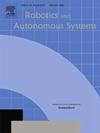Tightly-coupled LiDAR-IMU-wheel odometry with an online neural kinematic model learning via factor graph optimization
IF 4.3
2区 计算机科学
Q1 AUTOMATION & CONTROL SYSTEMS
引用次数: 0
Abstract
Environments lacking geometric features (e.g., tunnels and long straight corridors) are challenging for LiDAR-based odometry algorithms because LiDAR point clouds degenerate in such environments. For wheeled robots, a wheel kinematic model (i.e., wheel odometry) can improve the reliability of the odometry estimation. However, the kinematic model suffers from complex motions (e.g., wheel slippage, lateral movement) in the case of skid-steering robots particularly because this robot model rotates by skidding its wheels. Furthermore, these errors change nonlinearly when the wheel slippage is large (e.g., drifting) and are subject to terrain-dependent parameters. To simultaneously tackle point cloud degeneration and the kinematic model errors, we developed a LiDAR-IMU-wheel odometry algorithm incorporating online training of a neural network that learns the kinematic model of wheeled robots with nonlinearity. We propose to train the neural network online on a factor graph along with robot states, allowing the learning-based kinematic model to adapt to the current terrain condition. The proposed method jointly solves online training of the neural network and LiDAR-IMU-wheel odometry on a unified factor graph to retain the consistency of all those constraints. Through experiments, we first verified that the proposed network adapted to a changing environment, resulting in an accurate odometry estimation across different environments. We then confirmed that the proposed odometry estimation algorithm was robust against point cloud degeneration and nonlinearity (e.g., large wheel slippage by drifting) of the kinematic model. The summary video is available at: https://www.youtube.com/watch?v=CvRVhdda7Cw
求助全文
约1分钟内获得全文
求助全文
来源期刊

Robotics and Autonomous Systems
工程技术-机器人学
CiteScore
9.00
自引率
7.00%
发文量
164
审稿时长
4.5 months
期刊介绍:
Robotics and Autonomous Systems will carry articles describing fundamental developments in the field of robotics, with special emphasis on autonomous systems. An important goal of this journal is to extend the state of the art in both symbolic and sensory based robot control and learning in the context of autonomous systems.
Robotics and Autonomous Systems will carry articles on the theoretical, computational and experimental aspects of autonomous systems, or modules of such systems.
 求助内容:
求助内容: 应助结果提醒方式:
应助结果提醒方式:


